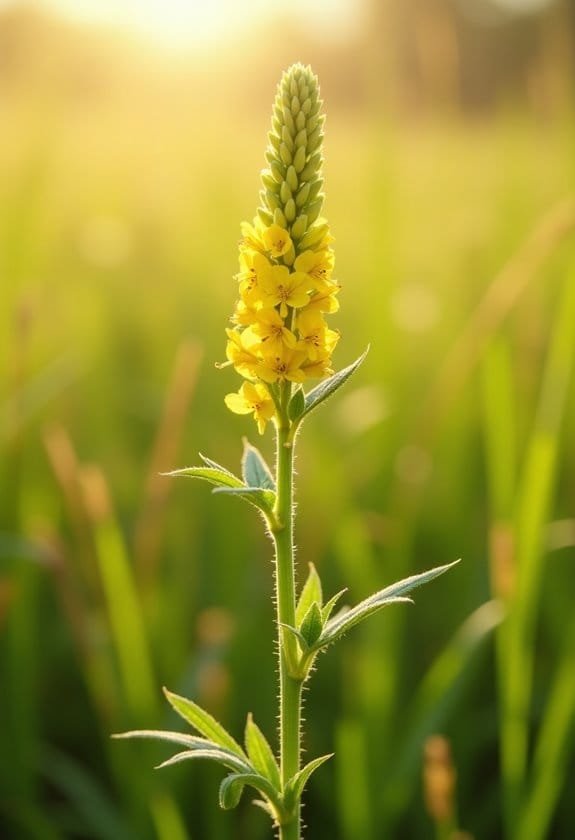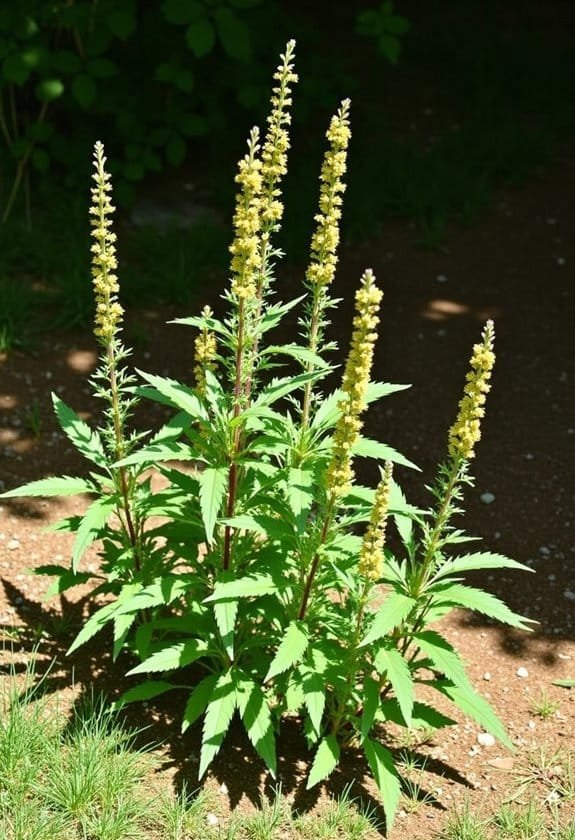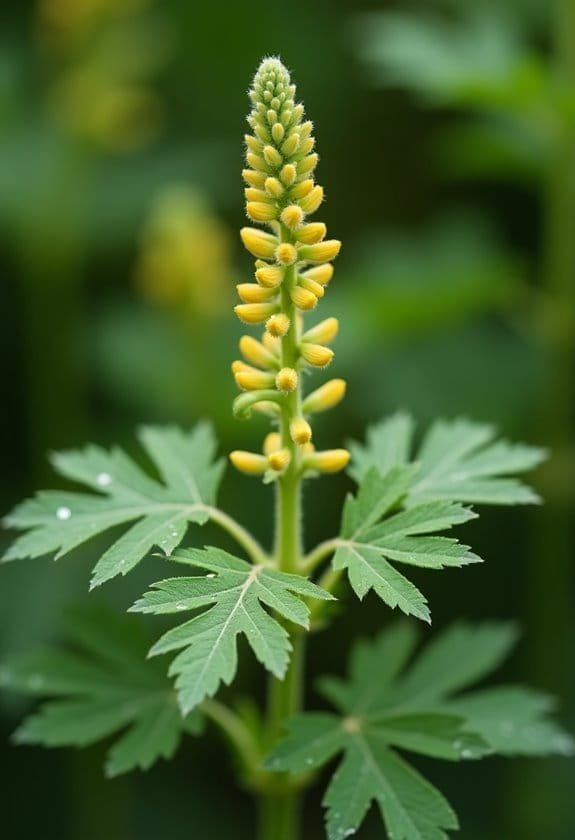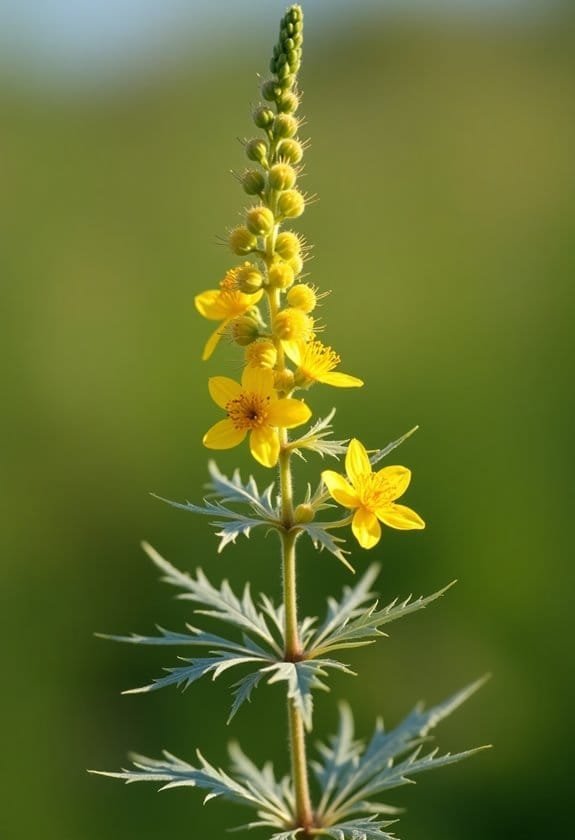Agrimony (Agrimonia eupatoria) is a resilient perennial herb in the Rosaceae family, reaching heights of up to 100 cm with distinctive yellow flowers arranged in spike-like clusters. It's characterized by serrated pinnate leaves and produces unique hook-bearing achenes measuring 0.6 cm in diameter, which aid in seed dispersal through animal movement. The plant thrives in damp meadows across Europe and Iran, demonstrating remarkable adaptability with its deep rhizome system and impressive 91% germination success rate. Known for its rich bioactive compounds, including flavonoids and tannins, agrimony's traditional medicinal applications and ecological significance continue to intrigue botanists and herbalists alike.
Main Points
- Agrimonia eupatoria is a perennial herb in the rose family, reaching heights of 100 cm with yellow flowers in spike-like clusters.
- The plant features serrated pinnate leaves and produces hook-bearing achenes for seed dispersal through animal contact.
- It thrives in damp meadows and pastures across Europe and Iran, preferring well-drained soil with consistent moisture.
- Flowering occurs from June to September, attracting pollinators like honey bees and hoverflies to its five-petaled yellow blossoms.
- Contains bioactive compounds including flavonoids and tannins, with traditional medicinal uses and ongoing research into potential health benefits.
Introduction

Agrimony (Agrimonia eupatoria) stands as a remarkable perennial herb in the rose family, distinguished by its tall stems that can reach impressive heights of 100 centimeters.
The plant's elegant yellow flowers, arranged in spike-like clusters, grace gardens and meadows throughout its blooming period from June to September, attracting essential pollinators such as honey bees.
This versatile herb has garnered attention throughout history for its complex array of bioactive compounds, including flavonoids and tannins, though modern science continues to investigate its traditional therapeutic applications.
Common Name
Known widely as "Church Steeples" and "Sticklewort," this perennial herb earned its common names from its distinctive flower spikes that resemble church steeples and its spiky fruit structure. The scientific name, Agrimonia eupatoria, contrasts with these descriptive common names that have become deeply embedded in traditional botanical nomenclature throughout Europe and beyond.
The metaphorical comparison to church architecture proves particularly apt, as the plant's yellow flower spikes rise prominently above its foliage, creating a striking vertical silhouette that can reach heights of up to 100 centimeters.
These architectural qualities become even more pronounced during the flowering period from June to September, when the plant stands tallest in meadows and pastures.
The "Sticklewort" designation stems from the plant's clingy fruit structure, which historically attracted attention from herbalists and foragers who encountered its adhesive nature while gathering specimens.
Throughout various regions, local variations of these common names exist, though they consistently reference either the plant's ecclesiastical appearance or its sticky characteristics, demonstrating how physical attributes often influence folk terminology in botanical naming conventions.
Scientific Name
The scientific classification Agrimonia eupatoria traces its roots to the Rosaceae family, where this medicinal herb stands among other notable members like roses, strawberries, and apples. This taxonomic placement reflects the plant's characteristic features, including its distinctive serrated pinnate leaves and yellow five-petaled flowers that bloom throughout the summer months.
Agrimonia eupatoria's scientific nomenclature aptly describes a plant that can reach impressive heights of up to 100 centimeters, making it a prominent figure in its native European and Iranian habitats. The species designation encompasses its unique reproductive strategy, featuring urn-shaped blossoms that develop into hook-bearing achenes measuring approximately 0.6 centimeters in diameter.
These specialized fruits demonstrate the plant's evolutionary adaptation for seed dispersal through animal transportation. The binomial name Agrimonia eupatoria serves as a universal identifier for researchers and botanists studying this versatile plant, which has demonstrated remarkable adaptability to various soil conditions and disturbed environments.
This scientific classification has enabled systematic documentation of the plant's medicinal properties and its ecological role in damp meadow ecosystems.
Overview
Rising gracefully in damp meadows across Europe and Iran, this perennial herbaceous plant showcases distinctive yellow flowers and serrated pinnate leaves that have captivated herbalists for centuries. Agrimony stands as a remarkable indication of nature's ingenuity, reaching heights of up to 100 centimeters while producing elegant spike-like racemose inflorescences from June through September.
The plant's most intriguing feature lies in its clever seed dispersal mechanism, where hooked, burr-like seed heads readily attach to passing animals' fur, ensuring widespread distribution across its native habitats. This adaptation has helped agrimony establish itself successfully in various environments, particularly in areas influenced by human activity.
Rich in volatile oils, flavonoids, and tannins, this versatile herb has earned its place in traditional medicine throughout history. Its presence in damp meadows and disturbed habitats speaks to its adaptability, while its distinctive appearance makes it easily recognizable among other meadow plants.
The combination of its serrated leaves, bright yellow blooms, and unique seed structures creates a botanical profile that's both scientifically fascinating and aesthetically pleasing.
Key Features
Agrimonia eupatoria stands as a striking perennial herb, reaching impressive heights of up to 100 centimeters in mature specimens.
Its distinctive appearance stems from its pinnate leaves with serrated margins, complemented by vibrant yellow flowers arranged in elongated, spike-like clusters known as racemose inflorescences.
The plant showcases its full splendor during its peak flowering period, which extends from June through September, attracting pollinators and contributing to its prominent presence in meadow ecosystems.
Growth Size
Growing in damp meadows and pastures, this resilient herb reaches impressive heights of up to 100 cm (39 inches), supported by a network of deep rhizomes that anchor it firmly in the soil.
As a perennial herbaceous plant, Agrimonia eupatoria demonstrates remarkable stability through its extensive root system, which enables sustained growth across multiple seasons.
The plant's impressive germination success rate of 91% and exceptional seed purity of 99% contribute greatly to its ability to establish and maintain ideal growth dimensions.
Its characteristic serrated leaves, arranged in a pinnate formation, extend outward from the main stem like nature's perfectly organized ladder, maximizing the plant's exposure to sunlight while maintaining its structural integrity.
The relationship between the plant's substantial height and its moisture-rich habitat suggests an evolutionary adaptation that allows it to compete effectively with surrounding vegetation.
These growth characteristics, combined with its deep-rooting system, make agrimony a particularly robust specimen that maintains its commanding presence in various environmental conditions while achieving its full height potential.
Appearance
The distinctive features of Agrimonia eupatoria create an instantly recognizable profile, with its dark green pinnate leaves arranged along sturdy stems that stretch skyward.
These leaves, characterized by their serrated edges and soft texture, present a striking appearance that distinguishes the plant from its woodland companions.
The plant's floral display manifests in elegant spike-like racemes, where short-stemmed blossoms emerge in organized succession.
Each flower exhibits five vibrant yellow petals complemented by an equal number of sepals, creating a symmetrical arrangement that attracts pollinators throughout its blooming period.
The most remarkable feature of agrimony's reproductive strategy lies in its fruit development, where hooks adorn the 0.6 cm achenes, facilitating dispersal through animal movement.
Perhaps one of agrimony's most enchanting characteristics is its aromatic profile.
When disturbed, the plant releases a distinctive spicy fragrance reminiscent of apricots, adding an olfactory dimension to its physical presence.
This scent emanates most strongly from crushed leaves and stems, serving as a reliable identifier for those familiar with the species.
Flowering Season
During peak summer months, from June through September, vibrant yellow blossoms adorn the spikes of Agrimonia eupatoria in successive waves. The flower spikes emerge in a distinctive racemose pattern, creating an elegant display as each bloom opens sequentially along the stem's length.
These carefully orchestrated blooms feature an intricate arrangement of five rounded yellow petals complemented by five protective sepals, all nestled within a specialized urn-shaped cup bristling with soft protective structures. The flowering process occurs systematically throughout the warm season, allowing the plant to optimize its reproductive potential in damp meadows and pastures where it typically flourishes.
As the flowering season progresses, the plant's reproductive strategy becomes evident in its clever seed dispersal mechanism. The blossoms gradually transform into hooked, burr-like seed heads, which have evolved to catch on passing animals' fur.
This adaptation guarantees the plant's genetic material spreads effectively throughout its preferred habitat, completing the seasonal cycle that began with those first summer blooms.
Growing Requirements

Agrimony requires specific growing conditions that mirror its natural habitat in damp meadows and pastures.
The plant thrives in well-drained soil with consistent moisture levels, while its deep rhizome system helps it establish strong root networks that support healthy growth.
Partial to full sunlight exposure is essential for ideal development, as these light conditions enable the plant to reach its full height potential of up to 100 cm and maintain its characteristic serrated foliage.
Light
Successful cultivation of agrimony depends heavily on proper light exposure, with the plant thriving best in full sun to partial shade conditions. The plant's dark green foliage requires a minimum of six hours of direct sunlight daily to maintain its robust growth and medicinal properties.
In natural settings, agrimony has adapted to varying light conditions, though it demonstrates ideal development when receiving abundant sunshine. While the plant can tolerate some shade, particularly during the hottest parts of the day, insufficient light exposure may result in reduced flowering and less vigorous growth patterns.
Careful consideration of light availability becomes especially important when selecting a planting location in gardens or cultivated spaces, where competing vegetation or structures might cast shadows.
In temperate climates, positioning agrimony where it receives morning sun and afternoon filtered light creates an ideal microenvironment that mirrors its natural habitat in meadows and pastures. This balanced approach to light exposure, combined with proper soil moisture management, enables the plant to establish strong root systems and maintain healthy vegetative growth throughout its growing season.
Soil
The soil composition plays a critical role in agrimony's development, with the plant showing a marked preference for well-drained, fertile ground that retains moderate moisture.
This adaptable herb has evolved to thrive in damp meadows and pastures, where its extensive root system can efficiently access essential nutrients and water resources.
Agrimony's robust rhizome structure enables the plant to establish itself successfully in various soil conditions, though ideal growth occurs in environments that maintain consistent moisture levels without becoming waterlogged.
The plant's remarkable adaptability extends to disturbed habitats and waste areas, where it can colonize and flourish despite less-than-ideal soil conditions.
In young grasslands, particularly those under five decades old, agrimony finds its most favorable growing environment, as these areas typically offer the balanced soil composition it prefers.
The soil's ability to retain moisture while allowing excess water to drain proves essential for the plant's long-term survival and proliferation, making it a reliable indicator species for well-structured soils that maintain appropriate moisture levels throughout the growing season.
Water
While soil composition sets the foundation for agrimony growth, proper water management brings out the plant's full potential. The plant's natural habitat in damp meadows and pastures reveals its preference for consistent moisture, though it demonstrates remarkable adaptability across varying water conditions.
During the critical germination phase, adequate water levels are crucial to support the impressive 91% germination rate that characterizes this species. As the growing season progresses from June through September, maintaining steady soil moisture guarantees prime development of both foliage and flowers.
The plant's deep rhizome system, while providing drought resistance, requires careful attention to drainage patterns to prevent waterlogging and subsequent root deterioration.
Successful cultivation of agrimony demands a balanced approach to irrigation, mimicking its natural habitat conditions while avoiding excessive saturation.
Gardeners should maintain consistent moisture levels throughout the growing season but allow the soil to drain properly between watering sessions. This careful water management strategy supports the plant's robust growth while preventing common moisture-related issues that could compromise its health and importance.
Temperature
Most agrimony species demonstrate ideal growth in temperate climates characteristic of their native European and Iranian habitats. The plant's natural distribution across these regions suggests it has evolved to thrive in environments with moderate seasonal temperature variations, avoiding extremes of both heat and cold.
While specific suitable temperature ranges aren't definitively documented, agrimony's prevalence in young grasslands and damp meadows indicates its preference for moderate growing conditions.
The plant's robust growth to heights of 100 centimeters occurs during warm growing seasons, though it demonstrates remarkable adaptability across varied environments. This adaptability suggests that agrimony can tolerate temperature fluctuations typical of temperate zones, where summers are warm but not scorching, and winters are cool but not severe.
The plant's successful establishment in disturbed habitats less than 50 years old further reveals its capacity to adjust to changing temperature conditions, particularly in areas where environmental conditions may be in flux. This temperature tolerance, combined with its ability to grow in various soil types, makes agrimony a resilient species within its preferred temperate range.
Pollinator Criteria
Agrimony's vibrant yellow flowers serve as magnetic beacons for a diverse array of pollinating insects, particularly hoverflies, flies, and honey bees, which are drawn to its abundant pollen production from June through September.
The plant's distinctive spike-like racemose inflorescences create an efficient landing platform for these pollinators, enabling seamless access to both nectar and pollen resources.
This mutually beneficial relationship extends to butterflies, especially the grizzled skipper, which relies on agrimony as an essential food source, contributing to the intricate web of pollination networks in damp meadows and grassland ecosystems.
Attracted Pollinators
The bright yellow spikes of Agrimonia eupatoria act as beacons for diverse pollinators, especially hoverflies, flies, and honey bees drawn to its abundant pollen. During its extended flowering period from June through September, these nectar-seeking visitors maintain a steady presence around the plant's distinctive inflorescences.
The plant's strategic flowering structure proves particularly beneficial for its pollinator relationships. Its short-stemmed blossoms, arranged in spike-like racemes, create accessible landing platforms for various insects seeking nourishment. This architectural adaptation guarantees efficient pollination while supporting the survival of multiple species in the ecosystem.
The plant's ecological significance extends beyond its role as a nectar source, as it serves as a critical host plant for butterfly species, especially the grizzled skipper.
Additionally, agrimony's clever reproductive strategy incorporates hook-like burrs that attach to passing animals, guaranteeing widespread seed dispersal. This dual approach to species propagation – attracting pollinators while utilizing physical seed transport – demonstrates the plant's remarkable adaptation to ecosystem dynamics and its contribution to maintaining biodiversity.
Pollination Method
During peak flowering season, successful pollination of Agrimonia eupatoria relies on specific criteria that attract its primary pollinators. The plant's distinctive yellow flowers, arranged in a racemose inflorescence pattern, serve as prominent visual beacons for potential pollinators searching for sustenance.
The pollination process occurs most actively between June and September, when the plant's urn-shaped flower cups present an accessible landing platform for visiting insects. These architectural adaptations, combined with abundant pollen reserves, create an efficient system that facilitates cross-pollination through various insect species, particularly hoverflies, flies, and honey bees.
The plant's reproductive strategy extends beyond initial pollination through its innovative seed dispersal mechanism. Once pollination is complete and fruits develop, they feature specialized hooks that readily attach to passing animals, ensuring widespread distribution of genetic material throughout the habitat.
This dual approach to reproduction – efficient pollination followed by strategic seed dispersal – demonstrates how Agrimonia eupatoria has evolved to maximize its reproductive success through both insect-mediated pollination and mammalian-assisted seed transport.
What Are the Benefits of Agrimony Compared to Thrift (Sea Pink)?
Agrimony is renowned for its calming herbal properties, often used in teas to support digestion and liver health. While the thrift sea pink plant overview highlights its resilience and ornamental charm in coastal gardens, agrimony’s benefits extend to traditional medicine, making it a versatile choice for those seeking natural remedies over aesthetic appeal.
Care & Maintenance

Agrimony's successful cultivation begins with selecting a well-drained location that receives adequate sunlight, while ensuring the soil remains consistently moist for its extensive root system.
Gardeners should maintain regular watering schedules during dry spells and remove spent flowers throughout the blooming season from June to September to promote continuous flowering.
The plant's adaptable nature makes it an excellent companion for other meadow species, though it's important to give it sufficient space to accommodate its spreading habit and deep rhizome structure.
Planting Tips
Successful cultivation of agrimony starts with understanding its basic growing requirements. The plant thrives best in environments that mirror its natural habitat, requiring consistently moist soil and ample space for its impressive vertical growth of up to 100 cm.
When selecting a planting location, choose an area that receives full sun to partial shade, which will support the plant's extended flowering period from June through September. The soil should be well-draining yet capable of retaining sufficient moisture to nourish the plant's extensive root system.
Space individual plants approximately 45-60 cm apart to accommodate their spreading habit and prevent competition for resources.
Before planting, prepare the soil by incorporating organic matter to improve drainage and moisture retention capabilities. Dig holes deep enough to accommodate the rhizomes, typically 15-20 cm in depth, ensuring they're positioned horizontally for ideal establishment.
In areas with heavy clay soil, consider creating raised beds or adding coarse sand to enhance drainage, as waterlogged conditions can lead to root deterioration and compromise the plant's long-term survival.
Ongoing Care
Maintaining agrimony requires three fundamental care practices: proper moisture management, timely pruning, and balanced fertilization. While the plant demonstrates remarkable resilience in various conditions, its ideal growth depends on consistent attention to these essential needs, particularly during the active growing season.
Regular monitoring of soil moisture levels plays an important role in agrimony's development, as the plant thrives in consistently damp, well-draining conditions without becoming waterlogged.
After the flowering period, strategic pruning helps promote bushier growth and prevents the stems from becoming leggy, which ultimately enhances the plant's wound healing properties. Throughout the growing season, applications of balanced organic fertilizer support robust development and abundant flowering.
Light exposure management deserves special consideration, particularly for individuals cultivating agrimony for medicinal purposes.
While the plant naturally adapts to various light conditions, excessive sun exposure may increase skin sensitivity, especially in people with liver conditions. Implementing partial shade during intense sunlight periods helps maintain the plant's therapeutic qualities while ensuring sustained growth and health.
Suggested Companions
Thoughtful companion planting enhances agrimony's growth while creating a balanced garden ecosystem. Common agrimony forms mutually beneficial relationships with several herbs that share its preference for moist, well-drained soil conditions. Chamomile and yarrow make excellent companions, as they attract pollinators and beneficial insects that support the overall health of the garden community.
When planning companion arrangements, gardeners should consider agrimony's impressive height potential of 100 centimeters, guaranteeing adequate spacing between plants to prevent competition for resources.
The deep rhizome system of agrimony works harmoniously with other perennial plants that establish robust root networks, collectively improving soil structure and nutrient availability throughout the growing area. These underground partnerships create a more resilient garden environment that benefits all participating species.
During the extended blooming period from June through September, regular maintenance of both agrimony and its companions guarantees sustained flowering and peak growth conditions.
Common Issues
Agrimony faces several notable pest challenges, including leaf-mining moths and rust fungi, which can compromise the plant's photosynthetic capacity and overall vigor.
While generally resilient, the plant's susceptibility to powdery mildew becomes particularly evident during periods of high humidity and poor air circulation.
Effective management typically involves maintaining proper spacing between plants, implementing good garden hygiene practices, and applying organic fungicides when necessary, though chemical interventions are rarely required due to the plant's natural hardiness.
Pests/Diseases
Common challenges facing agrimony plants include both pest infestations and fungal diseases that can greatly impact their health. One of the most significant threats comes from aphids, which can colonize the plants and cause substantial damage to their growth patterns and overall vigor. These tiny insects particularly target new growth, leading to stunted development and weakened plant structures that compromise the entire population's health.
In addition to pest concerns, agrimony faces several fungal challenges, with powdery mildew being a notable threat in environments where air circulation is poor. This condition typically manifests in damp conditions, creating a distinctive white coating on the plant's foliage that can impede photosynthesis and growth.
Root rot presents another serious concern, especially in waterlogged soils where proper drainage is lacking. To maintain healthy agrimony populations, regular monitoring for both pest activity and disease symptoms is essential, particularly in cultivated settings where plants are grown in closer proximity.
The plant's role as a wild host for various insect pests necessitates vigilant observation to prevent the spread of infestations to nearby vegetation.
Solutions
Effective management of agrimony's common issues requires a multi-faceted approach focusing on both prevention and treatment.
When cultivating this medicinal herb, gardeners must carefully balance environmental conditions while monitoring for potential complications that could affect the plant's valuable triterpene glycosides and other beneficial compounds.
For sunlight sensitivity issues, implementing shade cloths during peak daylight hours can help protect sensitive plants while still allowing sufficient light for growth.
Regular soil testing and appropriate amendments help maintain ideal pH levels, preventing nutrient deficiencies that could compromise the plant's health and medicinal properties.
To address potential pest infestations, introducing beneficial insects and maintaining proper spacing between plants can create a natural defense system.
Healthcare professionals recommend careful monitoring when using agrimony medicinally, particularly for individuals taking diabetes medications or those with liver conditions.
Users should track their response to the herb and maintain detailed records of any side effects, while working closely with their healthcare providers to adjust dosages as needed.
Regular blood sugar monitoring becomes especially important when combining agrimony with conventional diabetes treatments.
Summary

Throughout the ages, the perennial herbaceous plant known as Agrimonia eupatoria has served as both a medicinal herb and ecological resource. From ancient attempts to cure musket wounds to modern investigations of its biochemical properties, this remarkable plant has maintained its significance in herbal traditions worldwide.
Rising to impressive heights of 100 centimeters, Agrimony's distinctive yellow flowers and serrated pinnate leaves make it instantly recognizable in meadows and grasslands. Its clever reproductive strategy involves burr-like achenes that hitchhike on passing animals, ensuring widespread seed dispersal across diverse landscapes.
The plant's rich composition of phytochemicals, including flavonoids, tannins, and triterpene glycosides, has attracted scientific interest, though clinical evidence supporting traditional uses remains limited.
Beyond its medicinal applications, Agrimony plays a crucial role in ecosystem health by attracting essential pollinators like hoverflies and honey bees. While its potential therapeutic benefits are intriguing, particularly in blood sugar regulation, users must exercise caution due to possible interactions with diabetes medications.
This intersection of traditional wisdom and modern medical understanding highlights Agrimony's complex legacy in both human health and environmental systems.


